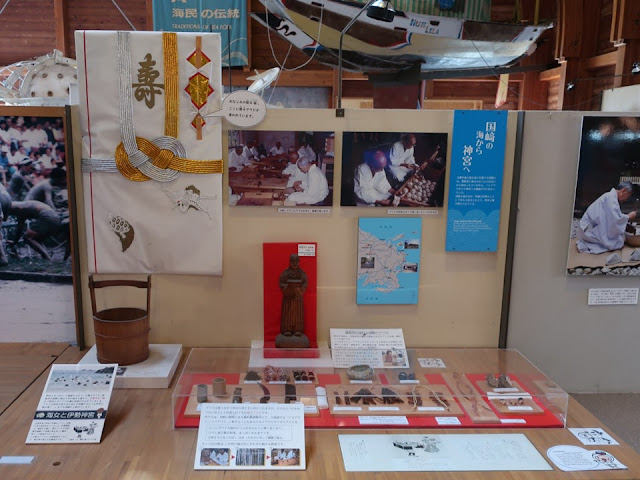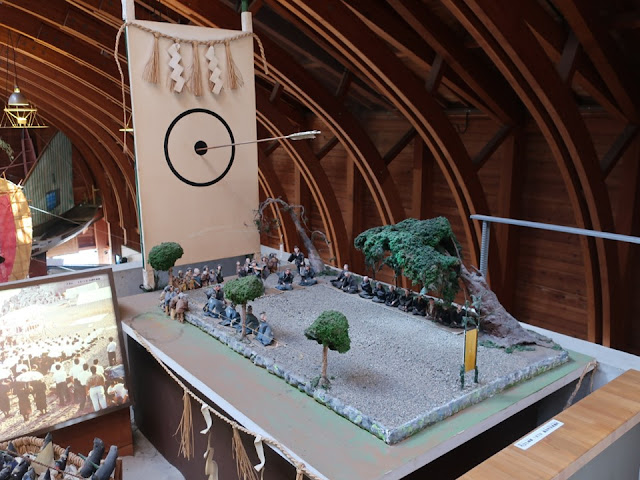The title of the panel is “The Japanese are ‘people of the sea’.” It says, “Japanese people have freely moved on the sea and have earned a living. We were maritime people.” It also shows a famous history scholar (Amino Yoshihiko), “The sea is a flexible barrier which separates Japanese Archipelago from the ocean. It also brings us rich seafood. Moreover, it is a traffic route to the world.” It's very crucial for Japanese.
Btw, topless women are depicted on
the picture above. It’s not matter for women in old days whether they were
topless or not, I think.
Part2:Fishers’ life, prayer and festivals (this article)、漁民の暮らしと祈り・祭り(本記事)
Part3:The regional fishery、伊勢志摩の漁
メインの展示棟の「海民(かいみん)って何者?」の展示です。「日本人は大昔から、海の暮らしに糧を求め、海を自由に動き回る、海に生きる海民だったのである」と書かれています。また、「海は列島を周囲から隔てる柔らかい障壁であるとともに、豊富な海産物を人々にもたらし、また列島を広く世界に結びつける交通路でもあった」という網野善彦の言葉も書かれています。
それにしても、絵に描かれた胸をはだけた女たち。昔の女性は、上半身は気にしないという印象が強いです。
There is a full-scale model of a fish-shop in the hall.
進むと、魚屋さんがあります。
We actually eat various kinds of seafood.
実際は、いろいろな魚貝の模型展示。我々は様々な魚介類をいただいています。
The cultivation of pearls initiated in this region.
三重県で始まった真珠の養殖。ここでも海女さんが活躍します。
Models of local fishing boats are exhibited. We can know well about sea and fishery here.
地域の漁船の模型も展示されています。とにかく、海と漁業のことがよく分かります。
Current technology and sea pollution are also exhibited.
最近の技術、海洋汚染についても展示されています。
Festivals and prayers relating Ise Shrine、伊勢神宮に関連する祭り・祀り
Ise Shrine in this region is the most famous shrine in Japan; it is dedicated to Amaterasu (a deity who is considered as the ancestor of the royal family). The giant fan is raised on the rice-planting-rite day. “太一” means Ise deity. It is said that sharks also come and worship the deity, so people don’t fish on the day.
地域のお祭りには伊勢神宮が大きく関わっています。中央にある「太一」は伊勢神宮を表し、田植えの神事で掲げられます。この日は、海からサメがお参りに来るというので、漁は休みです。
In Kunisaki area, people have offered seafood such as abalone to Ise Shrine more than two thousand years.
国崎の鮑など海の幸は、二千年にわたって伊勢神宮に届けられています。熨斗袋の右上の熨斗鮑も神宮に届けられた鮑の一つの形です。
Salt offered to Ise Shrine is also made by traditional methods.
塩も古来からの方法で作られ伊勢神宮にお供えされます。
The foods above are offered to Ise deity during the ritual in which the year's new rice harvest is served (Kanname-sai). It is written that Ise deity loves marine products so much. Not only fresh rice and mochi cakes but also seafood such as a tai-fish, a turban shell and so on are offered.
新穀を供える伊勢神宮の神嘗祭(かんなめさい)の神饌です。伊勢の神様は海の幸が大好きと書かれています。飯や餅もありますが、鯛やサザエなど海の幸が豊富です。
Fish, seaweed and salt are included in a daily offering.
日常のお供えにも、魚、海藻、塩が含まれます。
Deities in the myth and the emperor of Japan、分かりやすい
Sea-Folk’s Faith and Festivals、海の祭りと信仰
I’ll highlight two topics from the section above.
上の展示から2件、紹介します。
The title of this section is “Everything is Gods and Buddha”.
It says, “The small fishing village of ‘Ijika’ has dedicated many shrines to many gods. Moreover, each home has multiple shrines, charms and talismans. By comparison to city people and farmers, Sea Fork give importance to the gods and Buddha.” I understand the high-risk life at coast.
「なんでも神様仏様」のコーナーです。「小さな漁村・石鏡には氏神様の社をはじめ、竜宮さん、境の神など無数の神様が集まっている。家々の神棚にもたくさんの神社のお札がまつってある。都会や農村とくらべて、より神様仏様に頼らなければならぬ海村の暮らしがここにはある」と書かれています。命の危険が高い暮らしなのですね。
The title of this section is “In memoriam: Monuments to fish with appreciation” (exhibits are replicas). The map in front of the monuments shows forty-one actual ones in the prefecture. Many of them are dedicated to whales or tunas, but some are done to shellfishes (clams) or small fishes (sirauo). It is a typical and important Japanese way of thought to thank for receiving life of other creatures.
写真の供養塔は、いずれもマグロの供養塔の複製です。「魚たちへ感謝を込めて供養塔」と名付けられたコーナーです。供養塔の前にある地図には、県内の41カ所の供養塔が紹介されています。クジラやマグロが多いですが、ハマグリやシラウオも供養しています。命をいただくという日本人らしい考え方の表れだと思います。
Praying to the sea、海に向かって
I think it’s common among the people of the sea in the world to pray to the sea, however, I guess we Japanese pray a lot. It’s may be a nature of polytheism. The ritual at lower right is held on the New Year’s Day in Anori area. They pray big catch and safety to the sea deity (dragon).
世界の海民共通かもしれませんが、日本では、祈ることが多いと思います。そこここに神様がいる多神教の特徴かもしれません。右下は、阿児町安乗で元日に行われる神事です。海の神(龍神)に豊漁と安全を祈ります。
They offer a traditional dance to the sea in the New Year’s. It’s also an event praying for a big catch.
阿児町安乗では、1月2日に文楽・三番叟が海に向かって、浜で演じられます。これも、大漁を願う行事です。
Some people shoot an arrow in the New Year’s. It is a prayer for a big catch and is a fortune telling of their fishing of the year at the same time.
矢を射る神事(鳥羽市安楽島町の弓立ち神事)もあります。1月7日に行われ、豊漁を願い、同時に占います。
Festivals、祭り
Not only prayers but also festivals are exhibited. Fishing a model of a bonito or a whale in the festival (left), the festive boat race (center) and the talisman which decollates their entrance (right) are exhibited.
祀りだけでなく、祭りも紹介されています。カツオの模型を釣り、クジラの模型を突く祭りの演技(左)、船の速さを競う祭り(中央)。玄関にかける蘇民将来の魔除け(右)です。
The New Year Festival in Kamishima Island
It is a small island in which only 700
people live (in 1992). The islanders spend their all energy to the New Year
festival. Its climax is “Geitaa”. They bring a large wooden ring to the beach,
and lift it by bamboo poles. Then, they offer it to the local shrine. They are
so excited during the festival, and are granted power to get through the year.
A festival and a prayer of the people of
the sea are so energetic, I realized!
みんなが帰島する正月の祭り
鳥羽市の沖15km、伊勢湾口にある神島(周囲4キロ、人口700人@1992年)では、「数日間の正月行事に全エネルギーを費やして、その年の豊漁と安全を祈る。そのクライマックスが元旦の日の出と重なるゲーター祭なのだ」と書かれています。ぐみの木で作った輪を、浜辺に持っていき、女竹で高く突き上げます。そして、八代神社に奉納します。熱く盛り上がって、「また、一年がんばろう!」というエネルギーをもらうのだと思います。
海民の祭り、祀りは熱い、と実感!
Official website: http://www.umihaku.com/english/index.html
http://www.umihaku.com/
(in Japanese), accessed in September, 2023
Visited in
March, 2023
Previous post (part1 of this museum, Ama divers’ work and life/海女さんの漁と暮らし): Toba Sea-Folk Museum (1/3)、鳥羽市立海の博物館
(part1)
Next post (part3 of this museum, Fishery in Ise/伊勢の漁)::Toba Sea-Folk Museum (3/3)、鳥羽市立海の博物館 (part3)





















Comments
Post a Comment